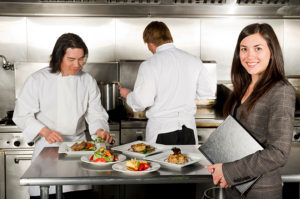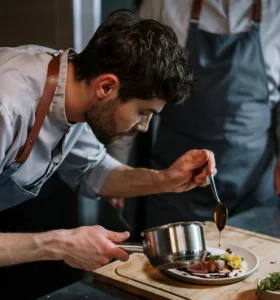16 Apr ACF Repost: 13 Things a Chef Must Do To Initiate Change in their Kitchen
ACF Repost: 13 Things a Chef Must Do To Initiate Change in Their Kitchen
There is an old quote about chefs that captures the wide breadth of expected daily tasks: “A Chef must think like a scientist, organize like an accountant, plate like an artist, and cook like a grandma”. Although this rings true, it is only a fraction of the responsibilities a chef is expected to perform. From preparing food to supervising the kitchen to inventory and scheduling staff, a chef wears many hats. However, the most important chef role is the Leadership Role and believe it or not, kitchens demand the most change.
Recently, the ACF blog page, We Are Chefs, posted an article on what a chef must do to become a change leader. So what does it take to become that change leader in today’s kitchen? Here are some thoughts by Chef Paul Sorgule of Harvest America Ventures.
1. CREATE A POSITIVE ENVIRONMENT 
The images of a kitchen where tension and angst are the norm, where the chef would yell and demean workers, where the observations and thoughts of the cook were never allowed to enter the conversation, are gone. The chef leader must invest heavily in creating an environment of engagement and support while still maintaining the standards of excellence and expectation that will result in success.
2. TEACH, TRAIN AND EMPOWER
In essence, the chef’s primary job must be to develop the people who work for him or her. All chefs are trainers, but they must also be teachers. This means that chefs need to take the time to develop the craft of teaching and dissect the knowledge that will help each employee grow and improve.
3. MENTOR AND ROLE MODEL
Leadership requires followers, and followers are attracted to those who help to guide them in pursuit of their dreams. The greatest accomplishment of a chef is not measured on the plate, but rather in how many young cooks under that chef’s tutelage were able to stay the course and take charge of his or her own kitchen.
4. PROMOTE RESPECT
Kitchens are melting pots of ethnicity, gender, race, size, age and beliefs – this is one of the greatest aspects of working in this environment. Chefs need to be the example and the facilitator of respect offered each and every member of his or her staff. A chef’s crew will emulate the standard of respect that is established at the top.
5. FACILITATE TEAM
The accomplishments of the chef are only possible through the unified actions of the people who tie on an apron in the kitchen. Working together for a common goal is the model that chefs need to facilitate. Hiring for team chemistry, being the example of working together, and insisting on collaboration is the standard of leadership change that defines every modern kitchen.
6. BE FISCALLY RESPONSIBLE
The financial success of a restaurant can never rest solely on the shoulders of the chef. Although it may very well be an integral part of the chef’s job description, it is through the conscious actions of every employee that financial success has a chance of becoming a reality. The chef leader must set the example and facilitate the expectation of everyone’s involvement in the process of seeing it to fruition.
7. CRITIQUE, NOT CRITICIZE
Anyone can criticize, but leaders understand that criticism is a shallow process that does nothing to set the stage for motivation or improvement. It is through honest critique that cooks will learn how to improve. The chef must take the time to compliment great work and coach critique with the time and effort to demonstrate how to improve upon an action. Teach and Train.
8. BE A BEACON OF EXCELLENCE & QUALITY
Expect a great deal from your employees – take the time to build their skills to the point where excellence can take place and then hold their feet to the fire. Most employees want to do great work and if they are confident in their ability and know that the chef will not accept anything but great work, then it will happen. What gets measured gets done. When the chef consistently demonstrates through his or her own actions what excellence looks like, then the benchmark is set.
9. BE THE GUIDING LIGHT OF SERVICE ORIENTATION
We all know that it’s common for cooks and service staff to complain about customers – chef leaders know that the reason their jobs exist is to serve the needs and desires of the guest. This example must be set if we are to change the attitudes of staff members. Service goes beyond the guest and as such becomes the responsibility of a leader to ensure that those who are in the role of meeting the needs and expectations of guests have the tools and the skills to accomplish that goal.
10. DEMONSTRATE STRENGTH OF CONVICTION
Chef leaders must clearly define their stakes in the ground whether they are with food quality, sourcing of ingredients, methods of preparation, the functions of a team, and/or the brand image of the restaurant. Once these standards are set and proclaimed then leadership is measured by how consistent the chef is with respect to those stakes in the ground.
11. PROMOTE PROFESSIONALISM – ALWAYS
There can be no exception with regards to professional demeanor, professional appearance, respect for others, or the way with which each cook approaches his or her position. The chef sets the tone for others to follow.
12. LISTEN – TRULY LISTEN
There’s a marked difference between hearing and listening. Listening requires paying attention, taking it in, keeping an open mind, taking mental notes and responding in a manner that demonstrates concern and respect for what is being offered. This is a change in kitchen culture that previously proclaimed that the chef spoke and others were expected to follow. Change demonstrates the value in a chef listening more and talking less.
13. BUILD A UNIFIED VISION and ACT
Yes, the tasks associated with the position of chef are substantial, but it is a leader’s role to think past today, define where the restaurant is headed and then facilitate the necessary action to get there. Followers will respond to the leader first, but crave an understanding of where they are headed together.
View the original article here: https://wearechefs.com/2018/03/29/chef-change-leader/
123ce
123 offers over 13 different courses on management in a culinary field and all courses are ACF approved. Learn how to perform your job more efficiently and effectively with a review and update on management, supervision, and leadership. Topics include traditional management functions, leadership theories, supervisory management, effective communication, motivation, conflict resolution, and delegation.






